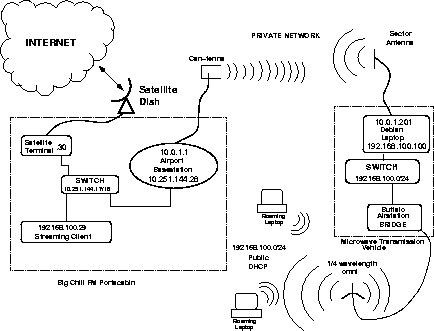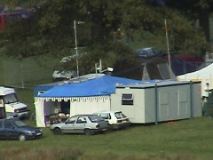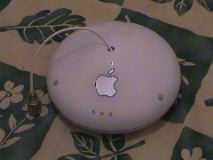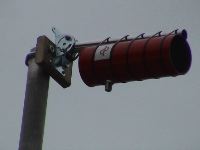

At the Big Chill Festival at Eastnor Castle (Herefordshire, UK) between 16-19 August 2002, Psand.net used satellite technology to provide the Big Chill FM team with a high-speed Internet connection to broadcast live Internet radio. In addition to this, a cross-site wireless network was set up to provide general mobile Internet access. This page discusses the technology used, the discoveries made and the lessons learnt.
Thanks to DC-Sat.Net for the loan of the satellite hardware and to Astra SES for Internet Connection.
Also a big shout to Big Chill FM for the phat sounds they pumped out over the course of the weekend.
Connection to the Internet was made using a bi-directional microwave satellite link, with a 90 cm dish mounted on top of a porta-cabin, used by Big Chill FM for their broadcasts. The satellite connection was split through a switching-hub to provide connectivity to the Internet radio broadcast client and a modified Apple Airport Base Station providing a wireless link to our monitoring and control vehicle, situated in an advantageous position for providing site-wide wireless networking. The vehicle was covered in green shade-netting to make it more discreet.

Our cunningly disguised monitoring and control vehicle.

Network diagram for the wireless network.
Some public Internet access was provided at various locations around the festival site with the aim of both entertaining festival-goers, and providing them with a useful service, as well as to enable range-interference testing with a variety of different types of wireless antennae.
The event was technically successful, and proved to be very popular and thought-provoking to visitors and spectators. The uses for the network were diverse, although e-mail appeared to be the most popular of the available services.
We used the Astra 1H satellite to provide Internet connectivity. This transmits and receives signals via the Astra Broadband Interactive Hub in Bexdorf, Luxembourg, which acts as ISP (Internet Service Provider), giving us 17 fixed IP (Internet Protocol) addresses.

The satellite dish mounted on top of Big Chill FM's porta-cabin.
The uplink is in the 29.5 to 30.0 GHz (Ka band) and has a throughput of 384 Kbps, and the downlink is 12.7 GHz (Ku band), with a throughput of 1 Mbps (capable of 6 Mbps on request). Ping time is around 650 ms.
It was required that we obtain a licence for the uplink for the duration of the festival and for this we supplied Astra with the GPS co-ordinates for the location.
The IP address of the Satellite indoor unit was 10.251.144.30
There are major health considerations when setting up the transmit hardware. The beam from the dish is approximately 1 metre wide and has an elevation of 30 degrees above the horizon at around 161 degrees (19 degrees East of South).
The porta-cabin had a solid, walkable, flat roof. We placed a SAT 5/B mount (from Eurosat in Bristol Tel: 0044 1454 616479) in the southern-most corner of the roof, and weighed it down with sandbags. The satellite hardware was then clamped onto the mount and was aligned and configured.
Big Chill FM were wholly responsible in this instance for obtaining the use of a streaming server on the Internet and for installing their own streaming client machine that would upstream the signal to this server for public broadcast. The streaming client used the Shoutcast plug-in for Winamp running on a Windows XP machine. This machine streamed the stereo feed from the mixing desk and the performances of the DJs and artists from the stages across the site. The receiving server was running Shoutcast software. We were able to monitor the status of the satellite connection by connecting to the streaming server ourselves from one of the laptops located in the control and monitoring vehicle. We knew that when the sounds stopped, something was awry.
The wireless network was implemented using 802.11b, a public, unlicensed band between 2.4 and 2.5 GHz. Bandwidth is rated at 11 Mbps and after packet handling can achieve throughputs of up to around 6 Mbps
The Ethernet connection from the Satellite Indoor Unit was connected via Category 5 cable to the a 100MB switching-hub which, in turn, was connected to the broadcast server and the WAN port of an Apple Airport Basestation (Apple's UFO-like wireless hub and router). Despite the Airport Basestation's lovely design and functionality, it has no external connection for extended range antennae, so we used a modified version, used previously for the Big Green Gathering.
The Airport Basestation was configured for a closed network and had only the MAC address of the Internet gateway laptop in it's access table.

Modified Apple Airport Basestation.
A 6 metre N type cable (URM67, signal loss of around 0.3 dB per metre) took the radio signal from the Airport Basestation up to a wave-guide can-tenna mounted on a radio mast on top of the porta-cabin.

Example of can-tenna used at Big Chill.
The line-of-sight signal from the can-tenna was then picked-up at the vehicle by a Buffalo extented range sector antenna. The sector antenna was connected to a Dell Inspiron 7000 laptop running Debian GNU/Linux and acting as an Internet gateway, which in turn took the signal through a second Ethernet interface providing a local LAN within the vehicle. The laptop ran additional services as an advanced router for the gateway through the Internet via the satellite.
|
|
A Buffalo WaveLAN wireless bridge was connected to the LAN to provide public access wireless network services via a quarter wave omnidirectional antenna mounted on the roof of the vehicle. This enabled us to achieve a much greater radio cell than would have been possible with the base station directly.
|
|
The IP address of the Airport Basestation was fixed at 10.251.144.28 and the streaming client at 10.251.144.29 with their default gateways set to 10.251.144.30 (IP address of the Satellite indoor unit) and Netmask 255.255.255.240. DNS for the Airport Basestation and streaming client was set to 212.56.224.20/194.164.97.10.
The Airport Basestation had an IP address of 10.0.1.1 on its LAN interface and the laptop running the Internet gateway IP addresses of 10.0.1.201 on its wireless interface and 192.168.100.100 on its Ethernet. In this instance we did not use DHCP as this was unecessary for the application.
Author: Dave Gough
Copyright (c) 2002 Psand Limited. Permission is granted to copy, distribute and/or modify this document under the terms of the GNU Free Documentation License, Version 1.1 or any later version published by the Free Software Foundation; with no Invariant Sections, with no Front-Cover Texts, and with no Back-Cover Texts. A copy of the license is included in the section entitled "GNU Free Documentation License".